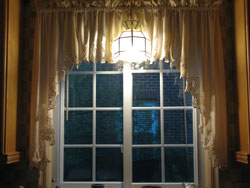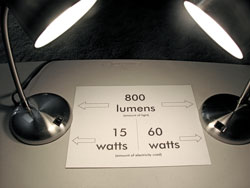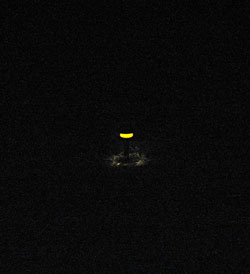Our lighting
 ©Janet Allen
©Janet Allen Our skylights are a form of solar energy
Although we found that our house wasn't suited for solar energy panels on the roof (primarily because of surrounding trees), we do use a form of solar energy: skylights. The natural light they provide elimininates at least some need for electric lighting.
Besides saving energy (and we do have our skylights very well insulated), natural light is much more pleasant than electric light. We have one skylight in the office and one in the family room. We also have skylights on the glassed-in porch, but those aren't generally replacing the use of electric lights.
Our house happens to have a lot of regular windows (about 35). These, of course, also provide natural light, but even though they're very energy-efficient windows, I suspect they result in a net increase in energy use.
Electric lighting
Aside from skylights and windows, we obviously have to rely on electric lighting. For about a dozen years, we used compact fluorescent light bulbs almost exclusively, but now we're shifting to LEDs.
Lights of the future today!
 ©Janet Allen
©Janet Allen Our first LED bulb
For Christmas a couple of years ago, we bought an LED bulb as our present (yes, that's the kind of thing we do for presents…) We've been so pleased with its performance that we bought a couple more for the most-used lights in our home.
At the time (about 2010) they were still somewhat pricey (I think we paid about $40 for each 60-watt equivalent bulb), but even then, they'll end up saving money—even more than the CFLs save, which themselves save a lot of money and energy compared to the old-fashioned incandescent bulb. They've since come down in price.
The LED does look odd in the package—it really is yellow. But when it's on, the yellow disappears, and the light is very similar to that of an incandescent bulb. One advantage is that all LEDs are dimmable, in contrast to the CFLs.
 ©Janet Allen
©Janet Allen LED light in kitchen
One of our most-used lights is the kitchen light above the counter. We have it on every evening. We can dim it down when we're in another room or turn it up if we're working in the kitchen. It's a very nice quality light and uses much less energy than even the CFL that was there previously.
I can foresee a time in the near future when we'll want all our lights to be LEDs, but our CFLs just aren't dying off very fast!
In the holiday season
 ©Janet Allen
©Janet AllenOur LED Christmas candles
Candles in windows have always been our favorite holiday decorations. In the past, we used nightlight bulbs in the plastic candles, stringing extension cords to reach each window. Every night, we'd have to go around and turn each one on, then turn them off at the end of the evening.
We were thrilled to discover these LED candles. They're battery-operated, so no extension cords are needed, and being LEDs, the batteries last a very long time. In fact, we save our used batteries from computer mice etc. to use in the candles. They seem to be able to squeeze the last bit of energy from the old batteries.
And not only are no extension cords needed, but once turned on, they come on by themselves at the same time each night, they stay on for six hours, then they turn themselves off. If this weren't enough, they have a slight flicker that seems very candle-like to me.
Along with a lighted wreath on the door, this comprises an entire holiday display. We like the welcoming glow of our simple window lights, and that's enough for us. Elsewhere, though, people seem to be competing to see who can produce the gaudiest, over-the-top displays.
Compact fluorescents
 ©Janet Allen
©Janet Allen Comparing a 60-watt incandescent and a 15-watt CFL: Both emit the same number of light (measured in lumens), even though the CFL uses 1/4 the energy
Since the early 2000s, we've used compact fluorescent (CFL) lightbulbs almost exclusively. We had tried some about twenty years ago, and they just didn't work, but for the past decade, they've improved so much that we can't tell the difference in terms of their functionality—only in the lower light bill. Unfortunately, people who haven't tried the newer bulbs still believe many of the myths around.
First, it's important to get good quality bulbs as it is with any product. People who buy cheap scissors, for example, might find they don't cut well, but do they decide that scissors don't work? Consumer Reports rates the different brands of CFLs, and the good brands work well, and we've found there's a definite difference between the cheap CFLs and the moderate-priced ones (they're no longer in the 'expensive' category).
A delay?Some of the older, cheaper bulbs have a delay before they come on, but the newest ones don't. Some may not reach for full brightness for a minute or two, but the annoying delay is gone. We still have some of these "delay" types, but they don't bother us. Still, though, when they finally burn out, we'll be happy to replace them.
Fitting in fixture or with lampshade? We haven't found a problem. For the few lampshades that fit over the bulb, we have bought the CFLs that are shaped like "regular" incandescent bulbs.
Dimmable? CFLs are dimmable IF you buy the kind that says it's dimmable. We have a few dimmable bulbs in some of our table lamps, and they dim just like incandescent bulbs.
Mercury? Yes, there's mercury in the bulb and caution has to be used when cleaning up a broken bulb. How often does a bulb break? We've only had one break while we were moving a lot of furniture. Besides, there's ever smaller amounts of mercury used every year. Mercury is bad stuff and that's why we're happy to use CFLs because they use less energy, fewer power plants need to be built, and so there's less mercury being emitted by the power plants. And the mercury power plants emit into the air is much more abundant and dangerous than any that might occur if by chance a CFL broke.
We don't expect to ever have to buy another CFL, though, because they last so long, BUT also because they're already old technology!
Exterior lighting
 ©Janet Allen
©Janet AllenOur solar light in the backyard
This is our backyard at night. It's dark, as night should be.
How did we get to the point—in a warming world, no less—that people use electric lights as a way to decorate their yards and house exteriors? This harms night-flying creatures besides being another way we lose our connection to the natural world.
For security lighting, we have a light on a motion detector, which comes on only when someone comes around. This is also a convenience when we come home since it lights up so we can find our keys.
